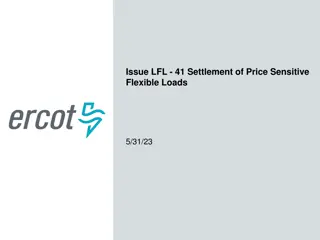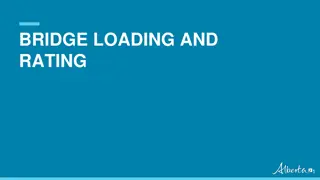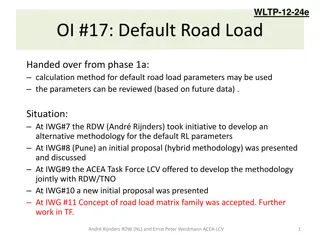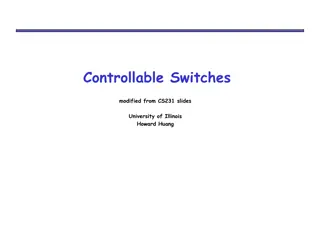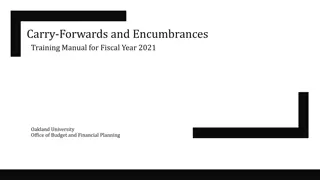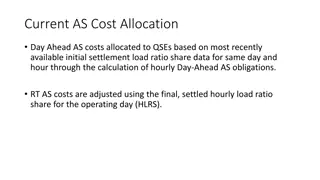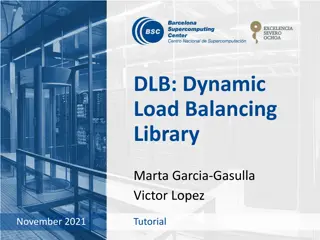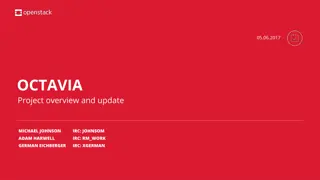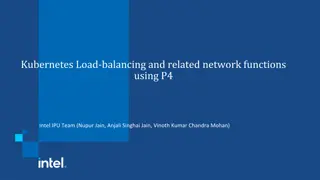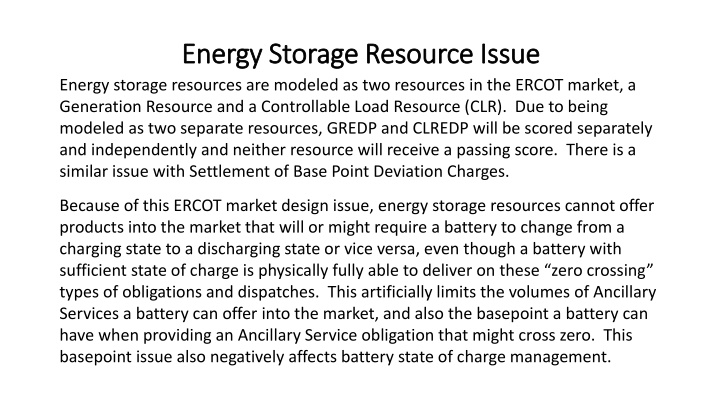
Optimizing Energy Storage Resources in the ERCOT Market
Discover the challenges faced by energy storage resources in the ERCOT market due to modeling constraints, impacting their ability to offer products efficiently. Learn about the proposed solutions to aggregate resources for better performance monitoring and Base Point Deviation settlement.
Download Presentation

Please find below an Image/Link to download the presentation.
The content on the website is provided AS IS for your information and personal use only. It may not be sold, licensed, or shared on other websites without obtaining consent from the author. If you encounter any issues during the download, it is possible that the publisher has removed the file from their server.
You are allowed to download the files provided on this website for personal or commercial use, subject to the condition that they are used lawfully. All files are the property of their respective owners.
The content on the website is provided AS IS for your information and personal use only. It may not be sold, licensed, or shared on other websites without obtaining consent from the author.
E N D
Presentation Transcript
Energy Storage Resource Issue Energy Storage Resource Issue Energy storage resources are modeled as two resources in the ERCOT market, a Generation Resource and a Controllable Load Resource (CLR). Due to being modeled as two separate resources, GREDP and CLREDP will be scored separately and independently and neither resource will receive a passing score. There is a similar issue with Settlement of Base Point Deviation Charges. Because of this ERCOT market design issue, energy storage resources cannot offer products into the market that will or might require a battery to change from a charging state to a discharging state or vice versa, even though a battery with sufficient state of charge is physically fully able to deliver on these zero crossing types of obligations and dispatches. This artificially limits the volumes of Ancillary Services a battery can offer into the market, and also the basepoint a battery can have when providing an Ancillary Service obligation that might cross zero. This basepoint issue also negatively affects battery state of charge management.
Energy Storage Resource Issue Energy Storage Resource Issue The GR and the CLR need to be aggregated for performance monitoring and BPD settlement purposes. If aggregated together for GREDP and CLREDP analysis, they will meet performance targets and they will not incur BPD charges. This NPRR is needed as soon as possible because under current Protocols, an energy storage resource is not able to fully participate in the ERCOT market.
Proposed Generation and Controllable Load Proposed Generation and Controllable Load Resource Group (GCLR Group) Resource Group (GCLR Group) Example: Current response, assuming each resource attempts to follow individual signal. 10 MW energy storage resource with a 5 MW Responsive Reserve Service (RRS) deployment. GR and CLR both receive a 5 MW RRS deployment. ERCOT required response is 10 MW. At T-0: Instructed GR @ 0 MW, Instructed CLR @ -10 MW At T-5: Instructed GR @ 5 MW, Responsive GR @ 0 MW, GR is deviating -5 MW Instructed CLR @ -10 MW, Responsive CLR @ -5 MW, CLR is deviating 0 MW ERCOT receives only 5 MW net response. Generation Resource has compliance deviation Current Instruction, Response and Deviation 6 4 2 0 T-0 T-2.5 T-5 -2 MW -4 -6 -8 -10 -12 Deviation CLR Deviation GEN Instructed CLR Instructed Gen Response CLR Response Gen
Proposed Generation and Controllable Load Proposed Generation and Controllable Load Resource Group (GCLR Group) Resource Group (GCLR Group) Example: Proposed Response with GCLR Group 10 MW energy storage resource with a 5 MW Responsive Reserve Service (RRS) deployment. GR and CLR both receive a 5 MW RRS deployment. ERCOT net required response is 10 MW. At T-0: Instructed GR @ 0 MW and instructed CLR @ -10 MW At T-5: Instructed GR @ 5 MW, Responsive GR @ 0 MW, GR is deviating -5 MW With GCLR Group, Responsive CLR @ 0 MW is deviating 5 MW With GCLR Group, CLR deviation offsets GR deviation and nets to 0 MW ERCOT receives required 10 MW net response. Without GCLR Group, in this example ERCOT receives 10MW response, but GR and CLR both have compliance deviations. Proposed Instruction, Response, Deviation 6 4 2 0 T-0 T-2.5 T-5 -2 MW -4 -6 -8 -10 -12 Deviation CLR Deviation GEN Instructed CLR Instructed Gen Response CLR Response Gen



